Sekhar brought us to his home village on
Gandhi’s birthday. We weren’t celebrating Gandhi’s birthday;
we went because it was Sunday, and it was the day before Sekhar’s
and my birthday.
Sekhar’s family lives in Irikupallam, which in Telegu means “congested
place”. I didn’t think it was that congested- Irikupallam
has 2,500 residents, and they are mostly farmers. Sekhar’s family
owns five acres of rice fields.
There were twelve of us who drove out to Irikupallam on Sunday: we
needed two Qualises to fit everybody. The trip out there was 250 kilometers,
on mostly decent roads. The closer we got, though, the bumpier the roads
got, and our butts got so sore.
We drove into the center, right next to a beautiful purple temple.
One left turn down the side street, and we arrived at Sekhar’s
house. We climbed out, stretched, and went through the gate and into
Sekhar’s family’s front yard.
We took off our sandals, filled pitchers with water from a large stone
basin in the front yard, and washed our hands and feet. Sekhar’s
mom and aunt and sister gave us towels to dry off, and we went inside
and met the family. They only spoke Telegu, but half of our group understood
it, and they translated for the rest of us.
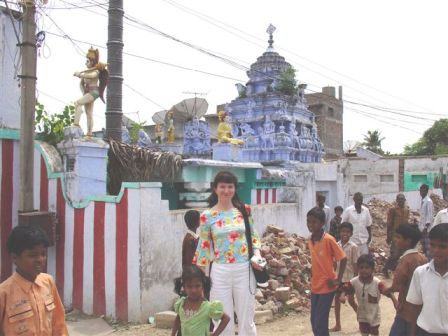 We sat down to some serious Southern Indian hospitality. The family
brought out wadas and sweets and coconut chutney and
water, and every time our plates were almost empty, somebody
came along and heaped up
more food on them. Pretty soon we were stuffed, and it
was funny watching how different people tried to stop
the food flow – Richa
said “no,
no, no”, and ended up with more, more, more. Sreelekha scolded
them and made them take back the food they snuck onto
her plate when she wasn’t looking. I left two wadas on
my plate as reverse decoys – if they were there, no more would
come. We sat down to some serious Southern Indian hospitality. The family
brought out wadas and sweets and coconut chutney and
water, and every time our plates were almost empty, somebody
came along and heaped up
more food on them. Pretty soon we were stuffed, and it
was funny watching how different people tried to stop
the food flow – Richa
said “no,
no, no”, and ended up with more, more, more. Sreelekha scolded
them and made them take back the food they snuck onto
her plate when she wasn’t looking. I left two wadas on
my plate as reverse decoys – if they were there, no more would
come.
We ate so much food that we forgot about our sore bottoms. Then Irina
and Julia suggested that we visit the temple, and we trooped outside,
put on our sandals, and walked the half block to the village center.
Somebody ran to get the priest, and we went through the side door of
the temple yard. We walked around the courtyard until the priest arrived.
When he came, he was wearing a dyothi. He looked like he just wrapped
a long towel around his waist, and threw another one over his shoulder.
He also looked like he had just woken up from his morning nap. Since
he was now awake, he went to work on waking up the gods for our visit.
The priest reached up and rang four bells in sequence, chanted something,
made some hand motions around the door, and then rang the bells again.
Sekhar said that he was warning the gods that he would be entering.
Then he unlocked and opened the door to the inner room, got a match
and some oil in a spoon out of a cupboard, and lighted the oil. He entered
the room, chanting and gesturing, and waved the flame and smoke at each
of the three idols inside. Sekhar explained to us that he was waking
up the gods for us – once awake, they would bless our arrival.
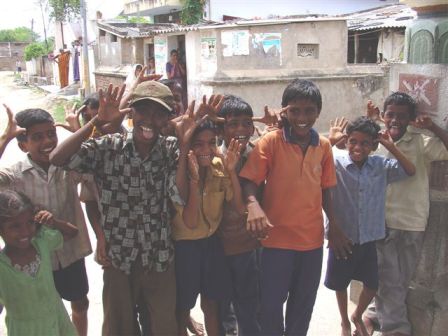 We were left outside the room, watching the priest moving around inside.
We weren’t quite sure what he was doing, but there was a lot of
muttering and singing and moving going on. Eventually
he came out, spoke with Sekhar, and we left. Sekhar said
that the priest suggested
we visit another temple, where the gods were already
awake and waiting for our visit. We were left outside the room, watching the priest moving around inside.
We weren’t quite sure what he was doing, but there was a lot of
muttering and singing and moving going on. Eventually
he came out, spoke with Sekhar, and we left. Sekhar said
that the priest suggested
we visit another temple, where the gods were already
awake and waiting for our visit.
We left the temple, and Sekhar asked if we wanted to see the rice fields.
Of course we did, but how were we going to get there? We could either
walk, or take a tractor ride. Since it was a few kilometers away, and
the sun was beating down on us, we opted for the tractor ride. While
we were waiting for the tractor, more and more of the villagers came
out to see us, and pretty soon we were surrounded by lots of curious
kids. Irina started taking their pictures and showing them the digital
images, and they pointed and laughed when they saw each other. I got
them dancing and making funny faces, and we had a good time waiting.
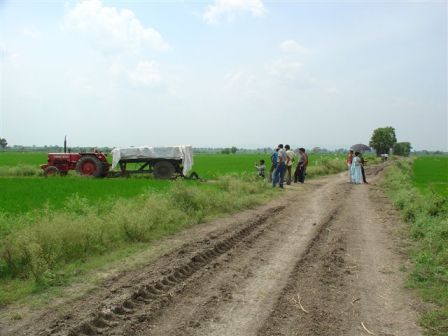 We clambered aboard the trailer, opened up some umbrellas to protect
us from the hot sun, and the tractor pulled us out to the rice fields.
Sekhar also pointed out fields of cotton, turmeric, and jute. Once we
got close to his family fields, Sekhar walked us out into the fields
and explained the mechanics of getting the water from the canals and
into the fields: the farmers make little ditches and dams with the dirt,
and the water flows through the fields, from one end to the other. We clambered aboard the trailer, opened up some umbrellas to protect
us from the hot sun, and the tractor pulled us out to the rice fields.
Sekhar also pointed out fields of cotton, turmeric, and jute. Once we
got close to his family fields, Sekhar walked us out into the fields
and explained the mechanics of getting the water from the canals and
into the fields: the farmers make little ditches and dams with the dirt,
and the water flows through the fields, from one end to the other.
As we were walking alongside a small canal, Sekhar told me that the
water came from the Nagarjunasaga Dam – and said, “Dennis,
you must drink some of the water.” It didn’t look that clean,
but when Sekhar drank some, I thought that I should do it too. I bent
down, cupped some water in my hands, and drank it. Out of the corner
of my eye I saw a dragonfly wing floating in the water in my hands just
as I took my sip.
The wing gut stuck in my throat. But I didn’t want to make a
big deal out of it, so I said, hopefully, “Wow, it’s nice
that the water is so clean.” And Sekhar smiled and said “no,
Dennis, it’s not very clean, but it’s auspicious to taste
the water that grows our rice.” Great - at least it made me forget
about my sore backside.
The tractor ride back seemed a lot longer. I think they wanted to show
us around, but after a few minutes of bouncing across the floor of the
shock-absorber-less trailer, baking in the heat, and shielding ourselves
with our umbrellas from the thorn bushes that seemed to reach out at
us as we passed, the rice and cotton and turmeric and jute fields all
looked the same. So to get our minds off our rear ends, I taught everybody
the bear song “Some years ago, I met a bear, a great big bear,
away out there”, then “There’s a hole in the bottom
of the sea,” and finally “And the dog went bow.”
Eventually the tractor reached a paved road, and we picked up speed.
This stopped the bumping and started a breeze, and we perked up enough
to notice Sekhar‘s primary school and high school. We returned
to the house and re-washed our hands and feet. Sekhar’s family
brought in some extra tables, and then they brought more and more food
for us to eat. The meal was incredible – we had rice with ghee,
lemon rice, some fried dishes, upma, many different kinds of chutneys
and curries, okra, and coconut ice cream. Finally we were stuffed. We
got up, went to another room, and each received a bowl of “ginju”,
which is made from the first milk of a buffalo after she gives birth.
Good thing they told us after we ate it.
As we were leaving, Sekhar’s family called us inside one last
time, and presented us with gifts – saris for Irina and Julia,
a dyothi for me, and cloth and money for Richa, Sreelekha, and Chaitanya.
We stopped at Nagarjunasaga Dam in the evenings, and saw the water
falls lit up with colored lights - absolutely magical. We watched the
Banjarra girls dance, and then drove home. After the trailer ride, the
bumps in the Qualis were hardly noticeable.
Sekhar told me about the rice farming business. Farming is a lot harder
than programming. Outside of major disasters, the amount of sunshine
or rain we receive doesn’t directly impact our paychecks. But
it makes a huge difference to the farmers of Irikupallam. This was the
first year in the last eight that there was enough rain to fill the
fields with enough water to grow enough rice to make a profit.
Not that there’s a lot of profit in growing rice. On a good year,
each acre of land produces 3,500 kg of unprocessed rice. Each kg sells
for 5 rupees, so an acre of land with a single crop (only one crop a
year in this part of Andhra Pradesh) can produce 17,500 rupees. Multiply
that by five and the total gross income is 87,500 rupees, or around
$2,000 US each year.
But that’s before expenses. Each acre of rice needs 10 people
to grow it, weed it, water it, and spray it. That’s 500 rupees
a day for the labor. Each acre of land needs seed and pesticide. All
told, it costs 8,000 rupees to grow an acre of rice, which means that
in a good year like this year, rice farmers will earn a profit of 9,500
rupees per acre of rice. Five acres means 47,500 rupees, or $1,100 US
per year that a typical rice farmer family earns.
I guess the pay isn’t so bad when you consider what other non-technical
people earn in India. Our driver earns a salary of 39,000 rupees each
year. But he gets paid whether the rice grows or not. Plus, he gets
tips, he can sleep most of the day while we’re at work, and he
gets overtime when he works more than 72 hours in a week (this is frequent
with our schedule). Farmers work much harder than Hussain does.
Sekhar and Arunabh explained how rice is grown. The farmers grow the
rice shoots in special beds. It’s very dense, and looks like a
lawn of uncut grass. The goal is to get these shoots eight inches long
so they can be planted in the fields.
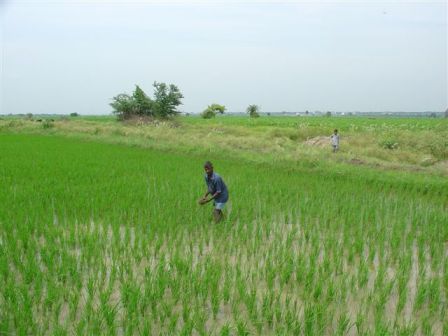 When the rains come in May, the farmers prepare the fields. They create
dams so the fields get filled with water. Once there is six inches of
water in the fields, they bring out the cows and plows, and they till
the fields until they turn into thick, black mud. In September, they
add more water, and they transplant the rice shoots to the fields, placing
them in evenly spaced clumps of five or six shoots. When the rains come in May, the farmers prepare the fields. They create
dams so the fields get filled with water. Once there is six inches of
water in the fields, they bring out the cows and plows, and they till
the fields until they turn into thick, black mud. In September, they
add more water, and they transplant the rice shoots to the fields, placing
them in evenly spaced clumps of five or six shoots.
For the next few months, the farmers ensure that the fields maintain
six to eight inches of fresh water. They cut out the weeds with their
sickles, collecting them to feed the cows and buffalos. They fertilize
the fields with cow and buffalo and human manure. They spread and spray
pesticides to keep the bugs away. All day the farmers and laborers are
in the fields, protecting their rice, keeping it alive and healthy.
This continues until January, when the rice stalks turn brown.
In January, the rice is almost ready for harvest. The
farmers drain the water from the fields to dry the
rice and loosen the kernels. This is the critical part:
if a stray rainstorm comes by while the rice is drying,
the crop is ruined. Fortunately in Andhra Pradesh,
this is a rare occurrence – rains come only between
May and October. When the rice is dry, the farmers
carefully cut the rice stalks with their sickles. They
gather the stalks, thresh them to shake loose the rice
kernels, and bag the kernels. These rice kernels are
brought to the mill, where they are husked and the
grains are extracted.
You’re probably asking yourself, “Why don’t the farmers
buy many acres of rice, so they can make more each year?” Good
question. The laws in Andhra Pradesh prevent any family from owning
more than ten acres of farmland. This restriction prevents large companies
from taking over and putting independent farmers out of a job. It also
protects the labor market: machinery is not cost effective on the small
scale of ten acres – it would take decades to recoup the capital
investment.
Whenever I eat a bowl of rice, I will appreciate the amount of manual
labor that went into preparing it. I will remember the feel of the bumps
of the tractor’s trailer, the dragonfly wing going down my throat,
and the heat of the sun on my head. I will remember the taste of the
dirty water and the wonderful spicy food. I will remember the smell
of the fresh earth, and the manure in the fields. And I will savor the
memories of the wonderful time we had with Sekhar’s family in
Irikupallam.
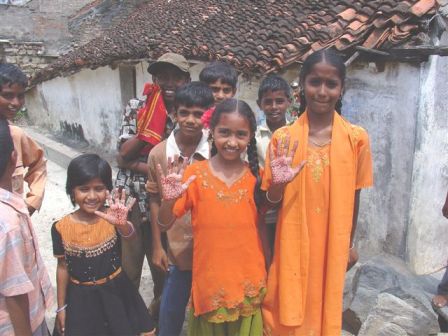
|

 We sat down to some serious Southern Indian hospitality. The family
brought out wadas and sweets and coconut chutney and
water, and every time our plates were almost empty, somebody
came along and heaped up
more food on them. Pretty soon we were stuffed, and it
was funny watching how different people tried to stop
the food flow – Richa
said “no,
no, no”, and ended up with more, more, more. Sreelekha scolded
them and made them take back the food they snuck onto
her plate when she wasn’t looking. I left two wadas on
my plate as reverse decoys – if they were there, no more would
come.
We sat down to some serious Southern Indian hospitality. The family
brought out wadas and sweets and coconut chutney and
water, and every time our plates were almost empty, somebody
came along and heaped up
more food on them. Pretty soon we were stuffed, and it
was funny watching how different people tried to stop
the food flow – Richa
said “no,
no, no”, and ended up with more, more, more. Sreelekha scolded
them and made them take back the food they snuck onto
her plate when she wasn’t looking. I left two wadas on
my plate as reverse decoys – if they were there, no more would
come. We were left outside the room, watching the priest moving around inside.
We weren’t quite sure what he was doing, but there was a lot of
muttering and singing and moving going on. Eventually
he came out, spoke with Sekhar, and we left. Sekhar said
that the priest suggested
we visit another temple, where the gods were already
awake and waiting for our visit.
We were left outside the room, watching the priest moving around inside.
We weren’t quite sure what he was doing, but there was a lot of
muttering and singing and moving going on. Eventually
he came out, spoke with Sekhar, and we left. Sekhar said
that the priest suggested
we visit another temple, where the gods were already
awake and waiting for our visit. We clambered aboard the trailer, opened up some umbrellas to protect
us from the hot sun, and the tractor pulled us out to the rice fields.
Sekhar also pointed out fields of cotton, turmeric, and jute. Once we
got close to his family fields, Sekhar walked us out into the fields
and explained the mechanics of getting the water from the canals and
into the fields: the farmers make little ditches and dams with the dirt,
and the water flows through the fields, from one end to the other.
We clambered aboard the trailer, opened up some umbrellas to protect
us from the hot sun, and the tractor pulled us out to the rice fields.
Sekhar also pointed out fields of cotton, turmeric, and jute. Once we
got close to his family fields, Sekhar walked us out into the fields
and explained the mechanics of getting the water from the canals and
into the fields: the farmers make little ditches and dams with the dirt,
and the water flows through the fields, from one end to the other. When the rains come in May, the farmers prepare the fields. They create
dams so the fields get filled with water. Once there is six inches of
water in the fields, they bring out the cows and plows, and they till
the fields until they turn into thick, black mud. In September, they
add more water, and they transplant the rice shoots to the fields, placing
them in evenly spaced clumps of five or six shoots.
When the rains come in May, the farmers prepare the fields. They create
dams so the fields get filled with water. Once there is six inches of
water in the fields, they bring out the cows and plows, and they till
the fields until they turn into thick, black mud. In September, they
add more water, and they transplant the rice shoots to the fields, placing
them in evenly spaced clumps of five or six shoots.